Diana and Ben take the bridge this week for a journey around the world and out into space, with a selection of the best science from the Naked Scientists worldwide travels. We find out how planets form from stardust in just tens on millions of years, and how to use winks, wobbles and blips to find planets around distant stars. We find out why the James Webb Space telescope must be very cool to pick up the hot infra-red radiation of deep space, and how the ExoMars rover could take us to previously unseen parts of Mars. Then we come back down to Earth with a bump (or should that be burp?) to discover the astronomical effort it takes to feed the population of the Olympic Village. Plus, in Kitchen Science, Dave tries in his own unique way to get a bottle rocket into orbit!
In this episode
02:10 - How Planets are Made
How Planets are Made
with Dr Michael Meyer, University of Arizona
Chris - Some of today's presentations at the AAAS science conference here in Boston were quite literally out-of-this-world. That's because scientists were explaining how they're looking for Earth-like planets. In other words, other worlds that could harbour life elsewhere in our Milky Way galaxy. How do planets form in the first place and why are they all different shapes and sizes? Earlier today I caught up with Michael Meyer who's been trying to solve this planetary puzzle at the University of Arizona.
Michael - I study star formation and planet formation. In particular, in the last few years we've been using NASA's Spitzer space telescope to understand the formation and evolution of planetary systems. We pick groups of stars that are very young, groups that are middle aged and groups of stars that are older and hope that we're watching a movie of what unfolds as one cohort evolves into the next.
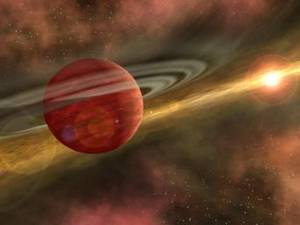 Chris - This gives you some clues as to what's going on 4.5 billion years ago in our own solar system, in other words how we got here?
Chris - This gives you some clues as to what's going on 4.5 billion years ago in our own solar system, in other words how we got here?
Michael - That's what we hope. Our programme is specifically focussed on studying sunlight stars in the disc of our Milky Way galaxy. We have a sample of 300 stars with ages only 3 million years after the stars first formed up to 30 million, 100 million, 300 million, a billion and then up to 3 billion years old. Not quite as old as our star, the sun.
Chris - How long does it take a system of planets to form in the first place?
Michael - It depends on which kind of planet were talking about. Our programme has been trying to study the evolution of dust and gas content. On the gas front we've determined that the amount of stuff needed to form Jupiter mass planets goes away on time scales of 3-to-10 million years. A planet like Jupiter has to form really fast. We think planets like Earth probably took 10-50 million years to form, at least in our own solar system. The new data we've received from the Spitzer space telescope seems to suggest that those processes might be very common about some of those stars.
Chris - That's not very long though, is it? That suggests that once planets are going to happen they happen quick.
Michael - That's right. If you sort of have a bunch of rocky things of order a kilometre in size and hit a go button gravity takes over and they will, on time scales of 10 to hundreds of millions of years, form most of the planets and the complement that we know of in our solar system.
Chris - Chat's the sort of step-by-step system of events that seems to happen to give rise to planets once'star begins to form?
Michael - Well, the disc of gas and dust that's left over from star formation is really a key part of that whole process or forming a young, sun-like star. Over time the gas and dust evolves in that the particles - the little dust grains that give a lot of the infra red emissions we see - can smash into each other and stick. It's kind of like the particles are in soot that you see rising from chimneys. Those tiny, tiny particles come together and form larger and larger things like pebbles and rocks and eventually the things that we might identify as boulders and then grow up to objects as large as the moon and Mars. That is the cascade of collisions that we think leads to planets like Earth.
Chris - Why are all the planets on the same planet though? Why do we find that they all go round lined up? Why does all that material settle into a disc, I suppose, rather than planets here and there all round the star?
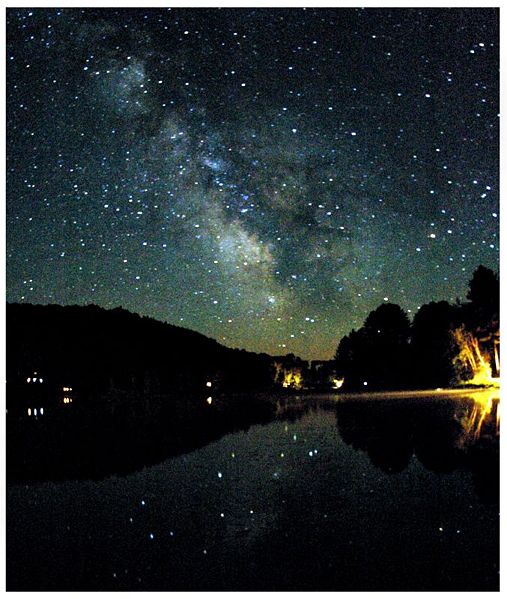 Michael - If you imagine our star like the sun forming from a cloud of dust and gas in space that's rotating, albeit ever so slowly, as that cloud contracts a lot of the material if forced into a disc by a principle of physics known as the conservation of angular momentum. It's the same thing that whizzes you to the outer edge of your car as you're speeding round a curve in the motorway. That same physical principle operates on spinning clouds of gas that form sun-like stars. It almost forces you into a situation where you collect mass in the centre but you must be surrounded by a disc of material left out there.
Michael - If you imagine our star like the sun forming from a cloud of dust and gas in space that's rotating, albeit ever so slowly, as that cloud contracts a lot of the material if forced into a disc by a principle of physics known as the conservation of angular momentum. It's the same thing that whizzes you to the outer edge of your car as you're speeding round a curve in the motorway. That same physical principle operates on spinning clouds of gas that form sun-like stars. It almost forces you into a situation where you collect mass in the centre but you must be surrounded by a disc of material left out there.
Chris - What makes the difference between whether we end up with a planet a bit like the Earth or one that's made of gas, like Jupiter? How does that happen?
Michael - Well, even to form a planet like Jupiter you need to start with a core that probably looks similar to a few-to-ten-times the mass of the Earth. The processes that lead from those tiny dust grains up to pebbles and boulders and things like the Earth take a certain amount of time. If you can get ten Earth masses of rocky material together about the distance of Jupiter from its sun before the gas goes away you have the potential to serve as a focal point, a nucleation site if you will of swarming and gathering the gas together. If that process takes too long and the gas is blown away before it can happen you might not have a Jupiter. Earth-like planets, we think, form anyway. Whether there is or isn't gas there you can still over a more leisurely period of time - 10, 30, 40, 50 million years - form rocky planets. We think that's one reason why we're seeing evidence of planet formation like rocky planets like Earth much more common[ly] than the evidence so far that we see for gas giant planets.
Chris - Is there any kind of magic formula where you always end up with planets that are certain sizes or are you now finding that in fact it's just a mixed bag?
Michael - Much more so a mixed bag. Our idea of planet formation suggests that it's messy. It's a very complex process. We think that's what leads to the large diversity of planetary systems that we see around stars like the sun.
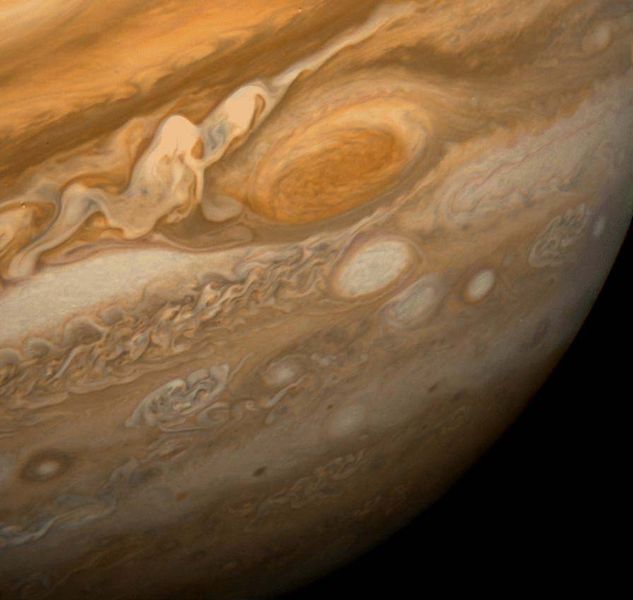 Chris - How does that effect our prospects of finding another Earth-like planet out there somewhere?
Chris - How does that effect our prospects of finding another Earth-like planet out there somewhere?
Michael - Well, as I said, we think our research suggests that planets like Earth could be very common. Like Earth simply means that they're rocky and that they're relatively close to their host star. Exact analogues are probably rare but what is it about the Earth that gives the possibility for the emergence of life? That's what all of us would really like to know. It would help us to better assess whether the sixty per cent of sun-like stars that we think might be forming terrestrial planets, whether those rocky planets could be places where life could develop.
Chris - Do you know what those magic ingredients are?
Michael - The elemental compositions that lead to life? Well, have a favourite word that we use in the emerging interdisciplinary field of astrobiology that's CHONSP: carbon, hydrogen, oxygen, sulphur, nitrogen and phosphorous. Those are the elements, the stuff of life that leads to the biochemistry of life.
Chris - Is it, based on your measurements, likely that most of these rocky worlds that form around planets will have a fairly even smattering of those or are there special accumulations of certain things in certain places that happen?
Michael - The chemistry of forming planetary systems is very complicated. We believe in a general way that the farther out you go the more likely you are to retain the carbon, nitrogen and oxygen in icy materials that could be very important to the emergence of life. In the inner part it's a bit of a mixed bag. The chemistry and the dynamics are so complex I can imagine a wide range of compositions for terrestrial planets.
Chris - Is it just stars a bit like our sun that we think give the best prospects for the evolution of life? Could we just be looking at any old star and hope to find some life there?
Michael - I think in our ignorance we focus on things we know. We only know of one planet that has given rise to life so we focus on terrestrial planets and we focus on stars like the sun. Again, in our ignorance that's what we know. I think over the years we're getting a sense that our perspective is a bit myopic. We need to step back and look at the formation and evolution of planetary systems around a whole host of stars. We shouldn't forget that the very first planets were discovered around the dead remnant of a very massive star, a pulsar. The first rocky terrestrial planets were in fact found in such an extremely exotic environment. As we learn more about how planets could form around stars much less massive than the sun, the cold, red end dwarfs: those are the most common stars in the Milky Way galaxy and if they are suitable places for life then life could be more common than we even could imagine.
Chris - I have to ask you to speculate with that point. What do you think the chances are during your professional life that we're going to find it?
Michael - I don't know. What I do know is that in the coming decades we will learn a tremendous amount about how common Earth-like planets are around stars like the sun. Whether or not we detect the biochemical signatures of disequilibrium which is really the stuff of life in the atmospheres of planets around other stars I can't venture a guess. I do believe that the biochemical origins of life will remain one of the key problems in science for the next century.
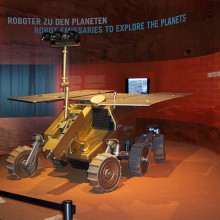
11:30 - ExoMars and Manned Mars Missions
ExoMars and Manned Mars Missions
with Dr John Bridges, University of Leicester
John - So here we have the ExoMars engineering prototype. Six-wheel drive rugged all-terrain vehicle which can go up and down 45 degree slopes and over large boulders. Ideal for Mars. We're developing the science instruments like the stereo cameras so we can build up three-dimensional views of Mars' surface and look at the rocks and decide how they forms.
Meera - Will it be taking any actual samples and analysing them?
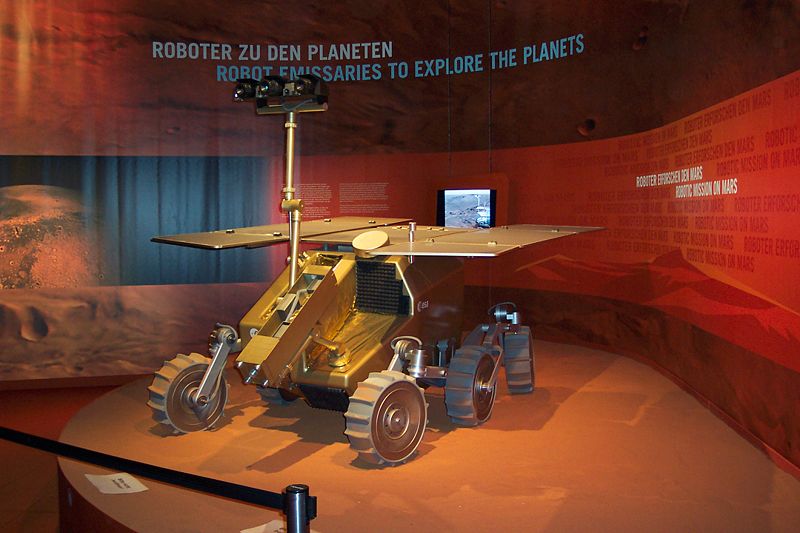 John - It has about 25kg of science instruments: different spectrometers to look at the chemical compositions of the rocks and the mineralogy so we can find chemical and mineral signatures or water on Mars or life on Mars. This is a real motivational factor for scientists and, I think, really the population at large to ask the big question - was there ever life elsewhere in the solar system? If we're going to address that question we need rovers like this with lots of science instruments.
John - It has about 25kg of science instruments: different spectrometers to look at the chemical compositions of the rocks and the mineralogy so we can find chemical and mineral signatures or water on Mars or life on Mars. This is a real motivational factor for scientists and, I think, really the population at large to ask the big question - was there ever life elsewhere in the solar system? If we're going to address that question we need rovers like this with lots of science instruments.
Meera - What will ExoMars be exploring?
John - ExoMars will go to a new place on Mars where no one has been to before. It'll be looking at rocks, looking at textures, using a microscope, looking at subsurface structure with our seismometer, finding out how the rocks were deposited. Were they deposited from water or from wind? As we piece together bits of information like that we find out what was happening on Mars millions of years ago. Today Mars is cold and dry. Millions of years ago, or billions of years ago, we think that it was probably warm and wet but we don't know for how long it was warm and wet. These are important questions to find out about Mars if you want to answer ultimately was there ever life on Mars and why did climate change on Mars from warm and wet to cold and dry.
Meera - When is ExoMars set to go?
John - 2013. It'll take nine months to get there. How do you actually go about testing this to make sure it will work and survive on Mars? For instance, the engineers from Astrium who are building the ExoMars prototype take it out to Tenerife and they practise with it over all sorts of rocky terrains to simulate the Mars surface going up and down 45 degree slopes, over rocky terrains: making sure it can do what we need it to do on Mars.
Meera - How about the environmental conditions of temperature and things like that?
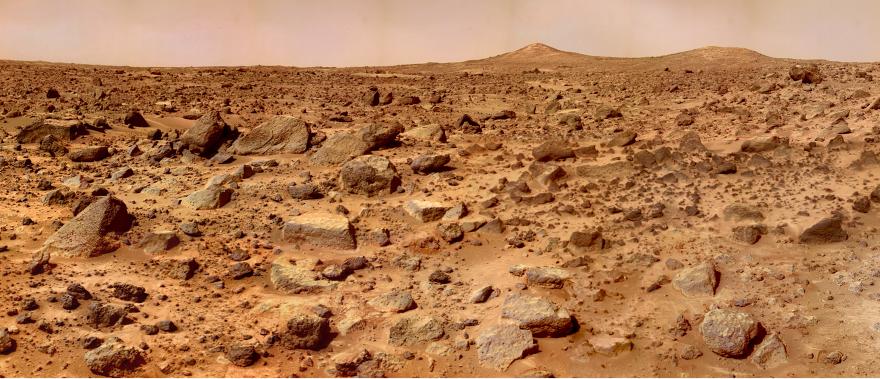 John - Mars is a really extreme environment. The average surface temperature on Mars is about -60 degrees centigrade. At the poles on Mars it can go down to -140 degrees centigrade. Just to put that in context, the lowest ever recorded temperature on Earth is about -80 degrees centigrade. It's a very cold and very dry place. Also, the atmosphere is very thin. It's about a thousandth of the atmospheric pressure of that on the Earth. That means a lot of the radiation from the sun can get through to Mars which would actually be stopped on Earth. It's much more harsh radiation environment. That means organic compounds are broken down on the Mars surface whereas on Earth they would be preserved. That's why we've got a drill on ExoMars so that we can get down fairly deep into the subsurface into areas which haven't been cooked, if you like, by the sun's radiation.
John - Mars is a really extreme environment. The average surface temperature on Mars is about -60 degrees centigrade. At the poles on Mars it can go down to -140 degrees centigrade. Just to put that in context, the lowest ever recorded temperature on Earth is about -80 degrees centigrade. It's a very cold and very dry place. Also, the atmosphere is very thin. It's about a thousandth of the atmospheric pressure of that on the Earth. That means a lot of the radiation from the sun can get through to Mars which would actually be stopped on Earth. It's much more harsh radiation environment. That means organic compounds are broken down on the Mars surface whereas on Earth they would be preserved. That's why we've got a drill on ExoMars so that we can get down fairly deep into the subsurface into areas which haven't been cooked, if you like, by the sun's radiation.
Meera - Are robotics the future of space exploration?
John - That's the question we're posing today because our exhibit is called 'Exploring the Solar System: Mankind or Machine?' Should we continue with robots and get lots of great science but should we also perhaps have an astronaut training programme? We're trying to engage here what people think. We've got a little pole here and what we've found this week is that the majority of people think that we should explore the solar system both by mankind and machine. We should have both.
Meera - What are the benefits of humans and the benefits of robots?
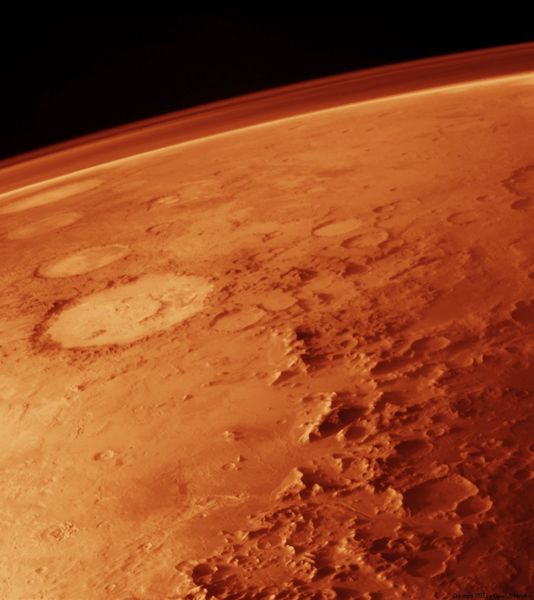 John - Robots perhaps you get more science for your money, if you like, immediately. It's less risky. You're not going to risk people's lives. You can send probes perhaps into the really extreme, cold environments or hot environments that would be very difficult to send people. Certainly over the next 10-20 years on Mars it's going to be dominated by robotic exploration. In the first samples we bring back from Mars it'll be done robotically. We can start doing tests with rovers and with samples brought back from Mars within the next 20 years. There can be benefits with sending people because they're such flexible machines, if you like. The autonomy, it'll be a long time before robots have that. The sheer scale of the endeavour to get people there will always mean that it is going to take longer. Talking to the people that have come to the exhibit and asking them, 'why do you think we should also send men?' I think what you might describe as a frontier spirit. It's about exploration, difficult to quantify in terms of absolute science but in terms of exploring the solar system there's a real drive, real excitement about man walking on the moon or perhaps ultimately walking on Mars. I think that's a powerful driving force. Even if it isn't purely scientific I don't think you can dismiss that. I think exploring by mankind: yes, we should do it but for me it's more of an exploration thing rather than purely scientific. It's great but it's not just about science.
John - Robots perhaps you get more science for your money, if you like, immediately. It's less risky. You're not going to risk people's lives. You can send probes perhaps into the really extreme, cold environments or hot environments that would be very difficult to send people. Certainly over the next 10-20 years on Mars it's going to be dominated by robotic exploration. In the first samples we bring back from Mars it'll be done robotically. We can start doing tests with rovers and with samples brought back from Mars within the next 20 years. There can be benefits with sending people because they're such flexible machines, if you like. The autonomy, it'll be a long time before robots have that. The sheer scale of the endeavour to get people there will always mean that it is going to take longer. Talking to the people that have come to the exhibit and asking them, 'why do you think we should also send men?' I think what you might describe as a frontier spirit. It's about exploration, difficult to quantify in terms of absolute science but in terms of exploring the solar system there's a real drive, real excitement about man walking on the moon or perhaps ultimately walking on Mars. I think that's a powerful driving force. Even if it isn't purely scientific I don't think you can dismiss that. I think exploring by mankind: yes, we should do it but for me it's more of an exploration thing rather than purely scientific. It's great but it's not just about science.
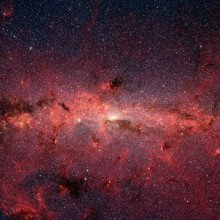
17:48 - Cool Running - The James Webb Space Telescope
Cool Running - The James Webb Space Telescope
with Dr John Mather, James Webb Space Telescope
Chris - What are the big questions that are out there that we want to answer with the next generation of space telescope?
John - I think the number one question is how did we get here and are we alone? Astronomers can tackle some pieces of this question by looking at the first objects that formed after the Big Bang, looking to see how galaxies are made, how stars and planets are formed from their gas clouds and finally how did the Earth come to be like it is?
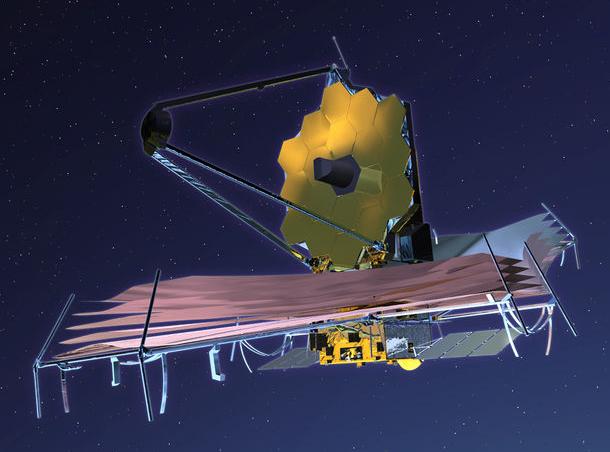 Chris - How are you hoping to answer those things?
Chris - How are you hoping to answer those things?
John - We have in mind a telescope which will be much larger and more powerful than the Hubble space telescope and would be launched in 2013 into deep space by a consortium of NASA leading the partnership with European and Canadian space agencies; pieces from around the world coming together to make this happen. Launch in 2013 on the Ariane rocket from French Guyana, near the equator.
Chris - When you say deep space, why can we not just put it in orbit around the Earth?
John - We need to put the telescope far from Earth so that it can cool down to a lower temperature so that it can detect the infrared radiation that is now the new frontier in space astronomy.
Chris - That's interesting. Why do you want to look at infra red? It seems paradoxical to look at light that we, as humans, can't see. I suppose that we as humans get used to seeing things we can see rather than some things like infra red we can't.
John - Yes, the new technology has opened up a new window for us. Infra red light comes to us from the most distant parts of the universe because of the expansion which causes something we call a red shift. Also we get to look inside clouds of dust and gas where things are cooler. Where they're not warm enough to emit radiation that we can see with our eyes but they still put out immense amounts of heat radiation. If you wanted to see yourself at a great distance you might use an infrared telescope.
Chris - Where will this telescope actually go? How far from Earth have you got to put it out there?
John - It's put out at 1.5 million kilometres from Earth, a place called Lagrange point 2 which orbits the sun along with the Earth every year.
Chris - How's it powered, solar?
John - It does receive power from the sun with solar cells.
Chris - What major experiments will it be doing as a telescope?
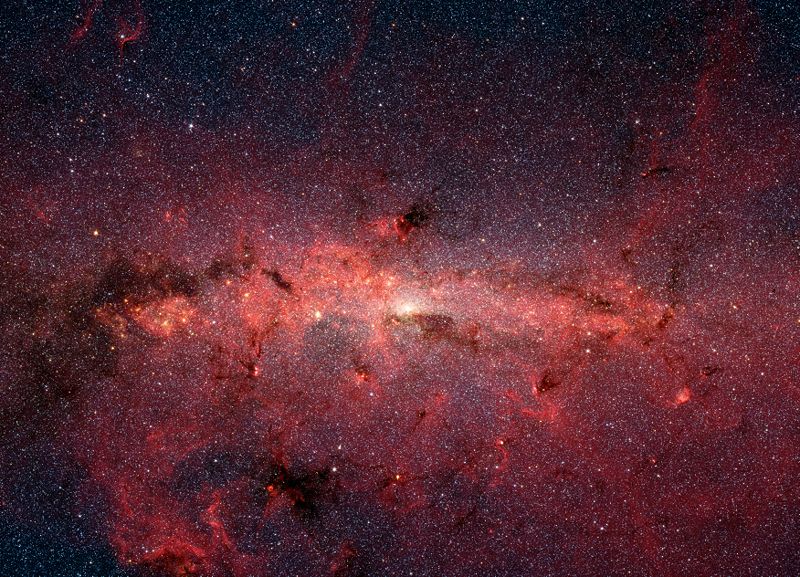 John - It has four instruments on it, cameras and spectrographs to cover the entire range of wavelengths from 0.6 microns which is red light that you can see with your eye way out into the near and mid-infrared. These four instruments will be able to look at distant galaxies, stars, planets, clouds of gas where they've been made and even little objects in the outer solar system.
John - It has four instruments on it, cameras and spectrographs to cover the entire range of wavelengths from 0.6 microns which is red light that you can see with your eye way out into the near and mid-infrared. These four instruments will be able to look at distant galaxies, stars, planets, clouds of gas where they've been made and even little objects in the outer solar system.
Chris - Dare I ask what's the price tag?
John - The lifecycle cost from the first day to the very last is four and a half billion dollars, which is actually less than the similar tag for the Hubble space telescope even though the telescope is much more powerful.
Chris - And when you say lifetime cost how long do you anticipate you'll be able to use this?
John - It'll take about another five and a half years to get it to launch and then we expect to run it for ten years.
Chris - That's quite cheap really, isn't it? On a ten year running cycle that's not bad.
John - For what it can do it's quite cheap. It's so spectacular in its capabilities that we expect miracles to be found, surprises to abound in the data and beautiful pictures as well.
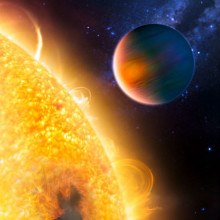
22:47 - Winks, Wobbles and Blips - Finding Exoplanets
Winks, Wobbles and Blips - Finding Exoplanets
with Dr Carole Haswell, Open University
Carole - What we're doing is presenting the methods that are used to find planets around other stars. Obviously we're very familiar with the planets in our own solar system. We've known about those for a long time. We can see them quite easily because they're bathed in light from the sun. To see a planet around another star is much more difficult because the star itself is very bright so we can't see the planets around another star directly just as we can't see the planets in our own solar system when it's daytime, when the sun is up.
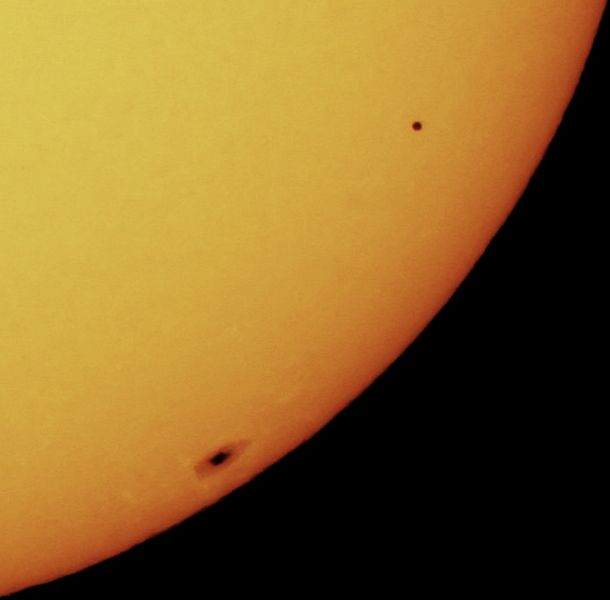 Meera - What are the techniques?
Meera - What are the techniques?
Carole - There's three techniques and we've actually given them nicknames. The three nicknames are wobbles, winks and blips.
Meera - Okay..
Carole - So probably the simplest way to understand is the winks method. That works if the planet around another star is lined up so it actually happens to pass in front of the star from our line of sight on the Earth. We see this phenomenon in our own solar system. If Mercury passes between us and the sun we observe a transit. There was a transit of Mercury recently: just a few years ago. Exo-planets too can transit. When that happens the planet is opaque so it blocks some of the light the star's emitting. An astronomer looking at that star will see it appear to get dimmer by a per cent or so. The transit will last typically for about 3 or 4 hours. What we do is we actually look at as many of the stars in the sky as we can and we measure their brightness roughly every ten minutes. We do that for the whole of the time that the star is visible in the sky so for a month every night that it's clear.
Meera - That's a lot of measurement.
Carole - It's a huge amount of measurement. A lot of the challenge in the project has not been the principle of it. It's quite easy to detect the one per cent dip in the brightness of a star but it's in the managing of huge amount of data to find the needle in the haystack, the few stars where there is a planet that is suitably aligned to execute a transit.
Meera - What's the wobbles technique?
Carole - The wobbles technique has actually been historically the most successful way of finding planets around other stars. The way it works is if you've got a star and a planet, you think about the planet orbiting the star but in fact it's a little bit more subtle than that because the planet has mass and the star has mass. Both the star and the planet are orbiting around their common centre of mass. The way to understand what the centre of mass is to think of a see saw. In order to make the see saw work you need to balance the people on the two ends of the see saw. If you now imagine a sumo wrestler and a small child on a see saw ...
Meera - Not quite balanced!
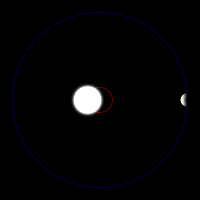 Carole - Not quite balanced and in order to balance it you would have to move the sumo wrestler very close to the pivot point of the see saw. If you did that you would find a balance point with the sumo wrestler sitting practically on top of the pivot and the small child at a large distance from the pivot. The pivot is actually the centre of mass of the sumo wrestler and the child. The planet and the star are very similar. The planet has much less mass than the star so the pivot point or the centre of mass is very, very close to the star. The planet has a large orbit which is why we think of the planet orbiting around the star but nonetheless the star has a small orbit. It's moving too around the common centre of mass just as the sumo wrestler on the see saw is moving slightly up and down. Astronomers can see stars and they can measure their motion. They can measure it by something that's called the Doppler effect which is an effect when something is moving towards you, if it's emitting waves as it moves towards you, the waves get squashed up. As it's moving away from you the waves get stretched out. With light this has the effect of changing the colour of the light. As the star is executing its small orbit like the sumo wrestler some of the time it's moving towards you and light is red-shifted. Some of the time it's moving away from you and the light is blue-shifted.
Carole - Not quite balanced and in order to balance it you would have to move the sumo wrestler very close to the pivot point of the see saw. If you did that you would find a balance point with the sumo wrestler sitting practically on top of the pivot and the small child at a large distance from the pivot. The pivot is actually the centre of mass of the sumo wrestler and the child. The planet and the star are very similar. The planet has much less mass than the star so the pivot point or the centre of mass is very, very close to the star. The planet has a large orbit which is why we think of the planet orbiting around the star but nonetheless the star has a small orbit. It's moving too around the common centre of mass just as the sumo wrestler on the see saw is moving slightly up and down. Astronomers can see stars and they can measure their motion. They can measure it by something that's called the Doppler effect which is an effect when something is moving towards you, if it's emitting waves as it moves towards you, the waves get squashed up. As it's moving away from you the waves get stretched out. With light this has the effect of changing the colour of the light. As the star is executing its small orbit like the sumo wrestler some of the time it's moving towards you and light is red-shifted. Some of the time it's moving away from you and the light is blue-shifted.
By studying that shift astronomers can see how big a circle it is that the star is moving around in its orbit. That then allows you to work out the mass of the planet that it's in orbit with just as if you looked at your see saw and measured the distance of the sumo wrestler from the pivot and measured the distance of the small child from the pivot. That would allow you to work out their relative masses.
The wobbles method allows you to detect a planet and to measure its mass. If you detect a planet that executes a wink you know not only the radius of the planet but you know the orientation of the orbit. If you then measure the Doppler shift and apply the wobbles method you then can know the mass of that planet exactly as well as knowing its radius. If you know the mass and radius you can measure the density. If you know the density that gives you a good idea of what the planet is made of.
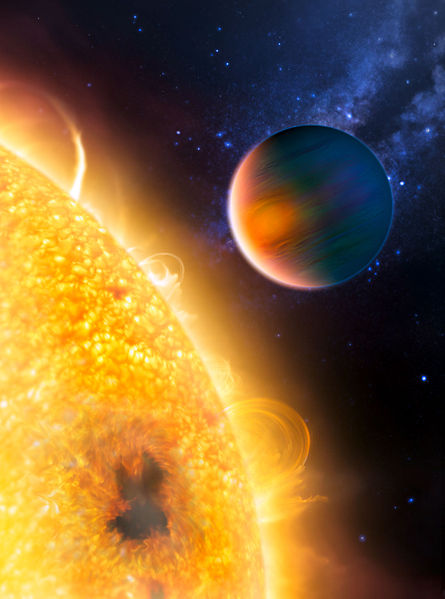 Meera - That's a great amount of information to be able to deduct.
Meera - That's a great amount of information to be able to deduct.
Carole - It is, considering you can't see the planet at all. For me that's what science is all about: applying the ingenuity of human thought to solving problems and learning things, learning as much as you can.
Meera - What is the third and final method?
Carole - The third and final method is the method of gravitational microlensing. We've given it the nickname blips. This method depends on the fact that mass curves space. This was something that was discovered by Einstein when he developed his theory of general relativity. All of the stars in our galaxy are actually moving. They're moving roughly in orbit around the centre of the galaxy. They're not orbiting in a very organised way so that means from our perspective a distant star and a less distant star will sometimes happen to line up exactly. When that occurs the light from the more distant star is actually travelling through the space that's been curved by the mass of the foreground star. The curved space acts like a lens on the background star's light. This gravitational lensing effect magnifies the light from the background star and makes it appear brighter. It takes about a month for the two stars to come into alignment and then drift out of alignment again. During the course of that month if you were watching that bit of sky you would see the star appear to get steeply brighter, reaching a peak which is exact, or as exact as it's going to get, and then it declines again as they drift out of alignment.
Meera - How does this enable you to see the planets going around these stars?
Carole - If the foreground star, the one that's acting as a lens, has a planet and one of the images - the background star that's being lensed by the curved space - passes close to the planet then the planet too has mass so the planet too curves space and adds its own, smaller lensing effect. Then you'd see an additional little sharp blip that actually brightens very dramatically and then returns back down to the smoother curve over the timescale of about a day. When you see that very characteristic blip you know that there must be a planet around the foreground lensing star and from various characteristics how bright it is, how quick it is. You can work out properties such as the mass of the planet and how far it is from its host star.
Meera - How many planets using all of these methods have you managed to find so far?
Carole - So far in total we know of about 300 planets around other stars. They're being found at a tremendous rate. We really are beginning to find these planets quite quickly because the methods are now all tried and tested. Groups of astronomers are organised to implement them efficiently.
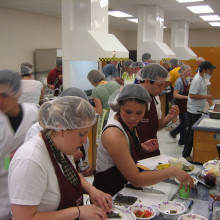
43:11 - Feeding the Olympic Athletes
Feeding the Olympic Athletes
with Madeleine Genner and Gary Leahy
Madeleine - in the Beijing Olympic village anticipation is building. The athletes are preparing to represent their countries and Irish-born Sydney-sider Gary Leahy is gearing up to serve millions of meals. Gary Leahy is senior executive chef for the Olympic Village. He arrived in Beijing just over a month ago in preparation for his third Olympics.
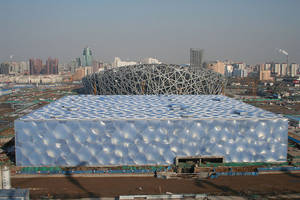 Gary - The first two weeks were pretty good because obviously there's no athletes here we managed to get in a lot of sight-seeing. I'm very impressed with Beijing as a city. Then the athletes have started to come in and we've just been working so hard for the last two weeks. We're doing about 33,000 meals a day and we peak at 60,000.
Gary - The first two weeks were pretty good because obviously there's no athletes here we managed to get in a lot of sight-seeing. I'm very impressed with Beijing as a city. Then the athletes have started to come in and we've just been working so hard for the last two weeks. We're doing about 33,000 meals a day and we peak at 60,000.
Madeleine - The dining hall at the Olympic village I understand can sit some 6,000 people. I presume the kitchens are pretty large too?
Gary - Yeah. The kitchen must be the size of a football field, or close to it. We have the kitchen set up into five sections. Each section has a menu and they fire the food, basically, then my job is I'm the expediter. All the food comes through me and I'm the link between the kitchen and the front of house.
Madeleine - And on the menu there are plenty of options. For breakfast there's scrambled eggs, sautéed zucchini [courgette], chicken with chick peas, octopus with peppers, red miso and conji. Gary Leahy again:
Gary - You'll see a big Chinese influence here which is very popular. Chinese food at all the games will actually be the most popular food that we do. There's stir fries and there's soups. There's a lot of Chinese, there's a lot of Mediterranean dishes, European-based dishes. Everybody is served across the board, no matter what sort of taste or background you come from I think we've got it pretty much covered.
Madeleine - I mean, of course you're also dealing with athletes who most of whom would have strict diet regimes. How do you account for that?
Gary - We probably have about 80 different items on the menu every day or meal period. We also have Halal stations and we have designated equipment in the kitchen for just pork and designated pork cauldrons. We're covering every base, really.
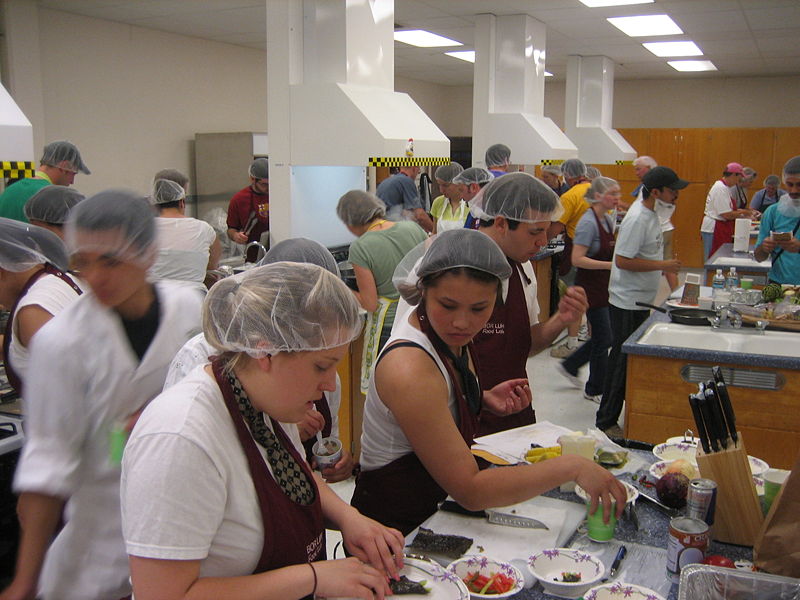 Madeleine - Since the Sydney Olympic games food security has become a much bigger issue. In Sydney all the food came direct from the suppliers every day but in 2004 in the wake of terrorist attacks like 9/11 security was much tighter. In Athens all food went to a warehouse first for security checks. In Beijing the authorities are leaving nothing to chance.
Madeleine - Since the Sydney Olympic games food security has become a much bigger issue. In Sydney all the food came direct from the suppliers every day but in 2004 in the wake of terrorist attacks like 9/11 security was much tighter. In Athens all food went to a warehouse first for security checks. In Beijing the authorities are leaving nothing to chance.
Gary - Food safety is really tight and obviously the Beijing government have people in the kitchen as well. Temperature checking, checking samples. We had the Beijing hygiene bureau about two weeks ago and they were walking us or talking us through that. Even the suppliers the Beijing government had employed to supply us with food. There's people from the hygiene bureau tracking all the food literally from the farm to fork the food is tracked by hygiene bureau peoples to make sure everything is in top shape.
Madeleine - As the games draws closer and closer what's it like being in the village? Obviously you've got a huge task ahead of you. It's a very different task to the athletes but it must be getting pretty exciting?
Gary - Yeah. The village is a buzz. A lot of athletes are walking around, strolling down the streets and laughing. It's really quite amusing, you know? The buzz in the village is just fantastic. The athletes are hanging their flags out of their apartments and, you know, it's really good.
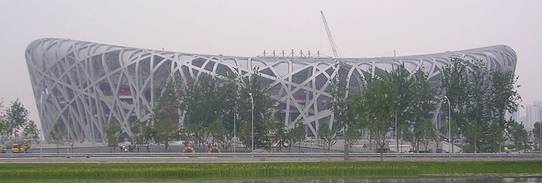
How does the Mars Phoenix Lander analyse samples?
We spoke to William Boynton on the show back in May about the mission so we decided to get back in touch with him to answer this question...
"We put the sample into a very small oven about the size of two drops of water and seal it to isolate it from the atmosphere. We then flush out the atmosphere that was sealed in the oven with the sample with a flow of pure nitrogen gas. The nitrogen gas is called a carrier gas and besides removing the atmosphere it is used to carry the evolved vapours generated during the heating over to the evolved gas analyser known as the sniffer. This sniffer is a mass spectrometer - a machine that you can find in any chemistry lab back here on Earth. This can accurately tell what molecules and atoms are in the sample."
Is hydrogen being created in the universe?
Ben - So if there was never a Big Bang, we've always had stars around - we know that what happens inside stars is hydrogen is converted into heavier elements like helium. If there was no Big Bang then surely by now all the hydrogen would have been used up, is that right Sarah?
Sarah - Well yes. The idea that the universe has already existed is known as the Steady State theory. This was developed in the 40s as an alternative to the Big Bang theory which is that the universe came into being and began to expand about 13.7 billion years ago. The Steady State theory has lost favour since the 1960s because a lot of the evidence actually supports the Big Bang theory, particularly after the discovery of cosmic microwave background radiation which is the sort of thing that the James Webb telescope will be looking for. Ben - And it's actually some of the stuff that you pick up on static on your TV.
Sarah - Exactly, and on your radio as well. You might think that even after 13.7 billion years the hydrogen might have all been converted but hydrogen still makes up about 75% of the normal matter in the universe. Diana - That's quite a lot, isn't it? Why is there so much still out there?
Sarah - Most of it's actually in low density, low temperature clouds of hydrogen where there just isn't enough energy to fuse the nuclei to make helium or other elements. This isn't a spontaneous reaction. It takes a serious amount of energy to do it which is why it did happen a second or so after the Big Bang and why it still happens in stars like our own sun. The heat and the energy present is there to do it but it just isn't there elsewhere in the universe.
My satellite dish is full of holes. Wouldn’t it be easier and cheaper to take all the holes out and just make a smaller dish?
Sarah - Before Chris scampered off on his holidays he managed to pen an excellent answer to this on our forum and he says that basically the dish is full of holes to reduce the weight and the wind resistance aka the likelihood of it being blown away from your wall. The dish works fine as a reflector despite it being full of holes because it's picking up relatively long wavelength radio waves and microwaves. Because the waves are longer than the diameter of the holes, they're easily reflected by the mesh in the dish because the waves won't fit through the holes. What the waves see is effectively a smooth, flat surface which focuses the waves onto a point where the detector is positioned. By doing this, gathering lots of waves over a large area and focussing them to a point you can get a much larger signal going to your TV.
Ben - This is exactly what we did with our parabolic mirror in last week's kitchen science. What we were doing though, instead of focussing satellite signals, is actually focussing light and heat down onto a point. You can actually use it the other way around and put the point source as your heat and use the dish to beam a jet of heat directly forward. Dave did this to me in his garage and it really was quite uncomfortably warm. Isn't this the same reason why you have a gauze in the front of your microwave?
Sarah - Yes, you know when you turn on your microwave you can see the light on inside but obviously the microwaves aren't coming out at you. It's because the wavelength of the microwaves is much longer than the wavelength of visible light. Although the light can get out through the mesh in the door the microwaves can't.
Ben - And this is why you don't cook your nose while you're watching your food cooking!
Why do storm clouds have such a clean, flat top?
Sarah - We actually had some great responses to this on our forum from Paul.fr but basically the story is that thunderstorms are formed of what are known as cumulo-nimbus clouds. These grow from the billowy cumulus clouds like the ones you see in cartoons and these grow upwards. The reason they do this is because if the sun heats up the ground you get thermals which is like warm air and it rises, pushing up the clouds. Ben - Are these the same thermals that birds use to lift themselves really high up in the sky, and also in hang-gliders?
Sarah - Yes. Big heavy birds like vultures, ones that live in quite hot areas, will wait for the thermals to rise before they can get up in the air because they're quite heavy so they find it hard to take off. Ben - Once these thermals have lifted the clouds how do they get the flat top?
Sarah - They keep growing upwards and then reach what is known as the tropopause which is the part of the atmosphere between the troposphere which is the bit nearest to the ground and the stratosphere which is the next layer up. Ben - What happens there?
Sarah - What you get here is known as an inversion which is where you get cold air sitting over warm air. What everyone's used to is the warm air rising and therefore being above the cold air. This doesn't happen in the stratosphere because it gets colder and colder as you go up. This means that the clouds can't go any farther as it hits the wall of warm air. It spreads out along the top and it's very flat. Obviously because the climate is very complicated there are other factors involved but that's basically the story.
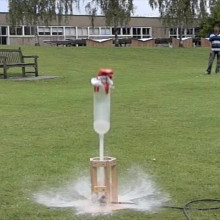









Comments
Add a comment